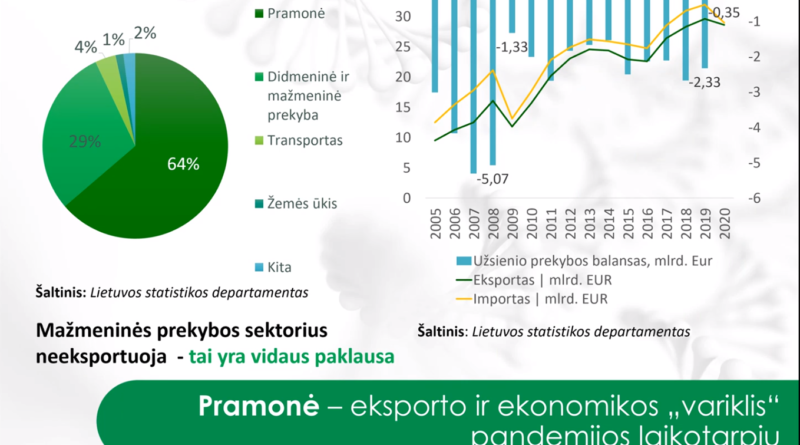Solutions for rapid economic recovery and transformation
In a video conference “Lithuanian Economy: Challenges of Postcovidial Rehabilitation” organized together with the Lithuanian Free Market Institute (LFMI), The Lithuanian Confederation of Industrialists (LPK) presented an assessment of the economic situation and an expectations, what governmental decisions are necessary to achieve economic recovery.
During the first wave of the pandemic, the Lithuanian economy suffered less compared to other European countries. According to the Economic Misery Index calculated by LFMI, Lithuania performed better than the EU average, but we were already fourth from the end during the second wave of the pandemic.
Competitiveness is crucial for recovery
“The features of 2020 of the world economy were recession and uncertainty. The economies of all countries are affected by pandemics and experiencing abrupt changes, and economists are more cautious in predicting the future and facing the challenge: how to adequately assess the current situation. As the pandemic continues, the Lithuanian Free Market Institute suggests remembering the Economic Misery Index. It is one of the most suitable tools for assessing the current situation, calculated as the total indicator of gross domestic product (GDP), unemployment and price growth,” said LFMI President Elena Leontjeva.
According to LPK President Vidmantas Janulevičius, the consequences of the protracted COVID-19 crisis will affect the future of the entire country’s economy. For companies to withstand the effects of a continuing pandemic, urgent state action is needed to enable businesses to remain sustainable and competitive. According to the calculations of the Bank of Lithuania, during the second wave of the pandemic, support decreased more than 4 times. Public debt has risen 11 percent, industrial sectors are shrinking, and there is no general picture of what economic policies would lead the country out of the looming chronic post-pandemic recession. It is necessary to create conditions for activation of investments in all Lithuanian companies and economic sectors. Economic productivity and competitiveness will be crucial for a rapid recovery and a long-term perspective.
Unemployment rate grows
One of the main reasons for the low GDP contraction was the almost neutral foreign trade balance. In Lithuania, the foreign trade balance, meaning the gap between exports and imports, has never been positive since the start of the collection of such statistics. It was only -350 million euros in 2020. In 2019 it amounted to -2.3 billion euros. During the pandemic, Lithuanian industrial enterprises, whose production makes up about 64 percent of Lithuania’s total exports, maintained similar export volumes as in 2019, which was the main reason for such a small contraction in GDP.
The deteriorating situation in the labor market is worrying. The pandemic had a stronger negative impact on the Lithuanian than the EU labor market. In Lithuania, the unemployment rate before the pandemic was about 6 percent, and at the end of the year it reached 15 percent and exceeded the EU average (7.5%). The pandemic affected the sectors in which young people work (catering, hotels). Before the pandemic, the youth unemployment rate was about 10 percent, and at the end of the year it rose to 26.9 percent. Paradoxically, the number of job vacancies in 2020 grew, mainly due to the asymmetric impact of the pandemic on the economy, the services and trade sectors were affected more than the manufacturing sector. New jobs were registered in manufacturing and transport, while jobs in the services and trade sectors declined. There have never been so many vacancies in the history of Lithuania, although at the same time the registered unemployment rate was growing.
Calls for continuity of the programs
According to LPK President Vidmantas Janulevičius, one of the most serious challenges in the long run is Lithuania’s competitiveness. Among the main problems facing Lithuanian industrial enterprises over the last five years are the slow growth of labor productivity and, at the same time, the rapidly rising labor costs. According to the data of the Lithuanian Department of Statistics, the monthly wage “in the hands” in 2015–2019 increased by 46.6% over the period, while labor productivity increased by only 26%.
“The new government has set an ambitious agenda. The key priorities identified – the Green Deal, digitalization and education – are far-sighted, important for the further development of our state and optimistic, but everything is determined by further implementation actions. We also need to talk about another component: the speed of implementation of the program and change. Further economic development depends in many cases on the pace of fundamental structural reforms: optimization and technological modernization of the education, health, social and public sectors, a system of industrial development and incentives for high value-added goods and services, and targeted and clear public employment relations and migration policies, to take account of the real demographic situation and the shortage of workers. In addition, it is necessary to improve the public procurement process, to introduce the most advanced education and higher education policy programs, which should have a continuity of at least 20 years. It is also necessary to ensure a balanced infrastructure development based on cost-benefit analysis,” said LPK President V. Janulevičius.




